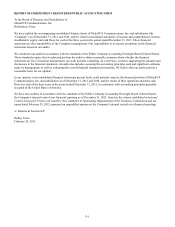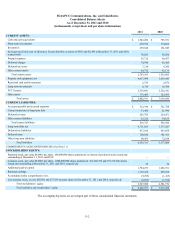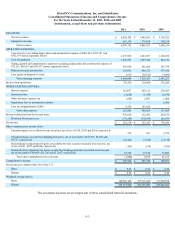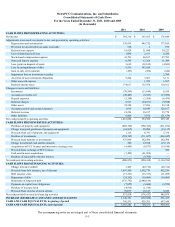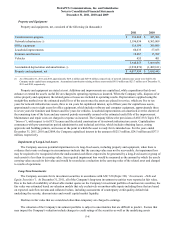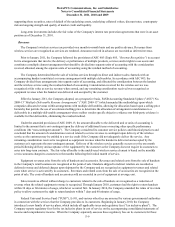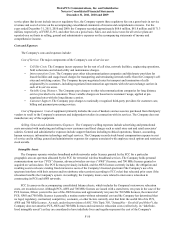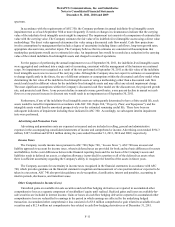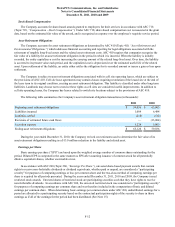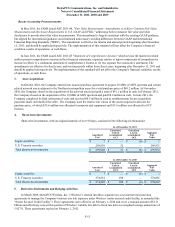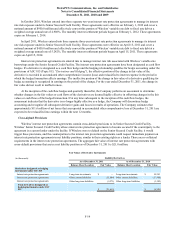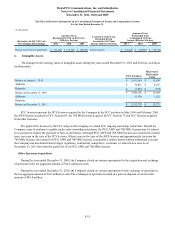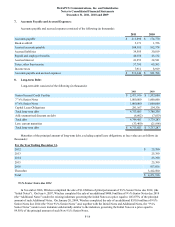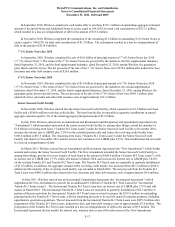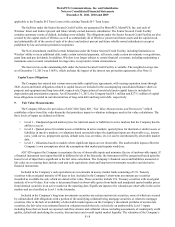Metro PCS 2011 Annual Report Download - page 117
Download and view the complete annual report
Please find page 117 of the 2011 Metro PCS annual report below. You can navigate through the pages in the report by either clicking on the pages listed below, or by using the keyword search tool below to find specific information within the annual report.MetroPCS Communications, Inc. and Subsidiaries
Notes to Consolidated Financial Statements
December 31, 2011, 2010 and 2009
F-11
spectrum.
In accordance with the requirements of ASC 350, the Company performs its annual indefinite-lived intangible assets
impairment test as of each September 30th or more frequently if events or changes in circumstances indicate that the carrying
value of the indefinite-lived intangible assets might be impaired. The impairment test consists of a comparison of estimated fair
value with the carrying value. The Company estimates the fair value of its indefinite-lived intangible assets using a direct value
methodology. The direct value approach determines fair value using a discounted cash flow model. Cash flow projections
involve assumptions by management that include a degree of uncertainty including future cash flows, long-term growth rates,
appropriate discount rates, and other inputs. The Company believes that its estimates are consistent with assumptions that
marketplace participants would use to estimate fair value. An impairment loss would be recorded as a reduction in the carrying
value of the related indefinite-lived intangible assets and charged to results of operations.
For the purpose of performing the annual impairment test as of September 30, 2011, the indefinite-lived intangible assets
were aggregated and combined into a single unit of accounting, consistent with the management of the business on a national
scope. No impairment was recognized as a result of the test performed at September 30, 2011 as the fair value of the indefinite
lived intangible assets was in excess of the carrying value. Although the Company does not expect its estimates or assumptions
to change significantly in the future, the use of different estimates or assumptions within the discounted cash flow model when
determining the fair value of the indefinite-lived intangible assets or using a methodology other than a discounted cash flow
model could result in different values for the indefinite-lived intangible assets and may affect any related impairment charge.
The most significant assumptions within the Company's discounted cash flow model are the discount rate, the projected growth
rate, and projected cash flows. A one percent decline in annual revenue growth rates, a one percent decline in annual net cash
flows or a one percent increase in discount rate would result in no impairment as of September 30, 2011.
Furthermore, if any of the indefinite-lived intangible assets are subsequently determined to have a finite useful life, such
assets would be tested for impairment in accordance with ASC 360 (Topic 360, “Property, Plant, and Equipment”), and the
intangible assets would then be amortized prospectively over the estimated remaining useful life. There have been no
subsequent indicators of impairment including those indicated in ASC 360. Accordingly, no subsequent interim impairment
tests were performed.
Advertising and Promotion Costs
Advertising and promotion costs are expensed as incurred and are included in selling, general and administrative
expenses in the accompanying consolidated statements of income and comprehensive income. Advertising costs totaled $194.3
million, $187.3 million and $150.8 million during the years ended December 31, 2011, 2010 and 2009, respectively.
Income Taxes
The Company records income taxes pursuant to ASC 740 (Topic 740, “Income Taxes”). ASC 740 uses an asset and
liability approach to account for income taxes, wherein deferred taxes are provided for book and tax basis differences for assets
and liabilities. In the event differences between the financial reporting basis and the tax basis of the Company's assets and
liabilities result in deferred tax assets, a valuation allowance is provided for a portion or all of the deferred tax assets when
there is sufficient uncertainty regarding the Company's ability to recognize the benefits of the assets in future years.
The Company accounts for uncertainty in income taxes recognized in the financial statements in accordance with ASC
740, which provides guidance on the financial statement recognition and measurement of a tax position taken or expected to be
taken in a tax return. ASC 740 also provides guidance on de-recognition, classification, interest and penalties, accounting in
interim periods, disclosures, and transition issues.
Other Comprehensive Income (Loss)
Unrealized gains on available-for-sale securities and cash flow hedging derivatives are reported in accumulated other
comprehensive loss as a separate component of stockholders' equity until realized. Realized gains and losses on available-for-
sale securities are included in interest income. Gains or losses on cash flow hedging derivatives reported in accumulated other
comprehensive loss are reclassified to earnings in the period in which earnings are affected by the underlying hedged
transaction. Accumulated other comprehensive loss consisted of a $3.6 million comprehensive gain related to available-for-sale
securities and a $12.9 million net comprehensive loss related to cash flow hedging derivatives as of December 31, 2011.


